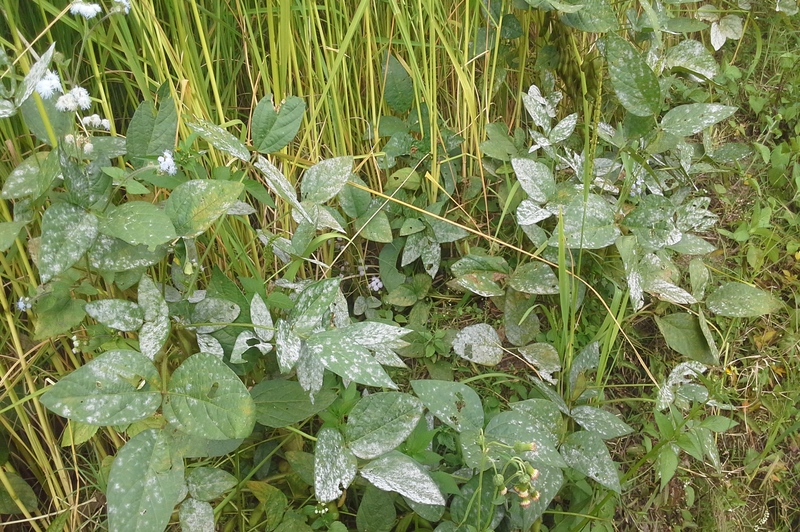Are you exhausted from seeing mildew on your garden plants? Ever wondered what temperature kills powdery mildew spores?
If you have asked yourself these questions, you have come to the right place. In this article, we got the information that will help you get rid of your powdery mildew problems.

What Are Powdery Mildews?
Powdery mildew is a widespread plant disease caused by different fungal species such as Erysiphe spp., Golovinomyces spp., Leveillula taurica, Oidium spp., and Podosphaera spp. These fungi produce spores (conidia) that travel through the air to infect other plants.
If you are not sure if your plants are suffering from this disease, this useful article will provide the answer to the question “what does powdery mildew look like”.
Unlike other fungal spores, powdery mildew spores do not require free moisture from the environment to germinate. That is why they can spread easily once a plant has been infected.
It only takes at least 48 hours for a spore to germinate and form new spores. Warm days with low relative humidity and cold nights with high relative humidity favor the growth of powdery mildew spores.
What Temperature Removes Powdery Mildew Spores?
The leaf temperature above 90⁰F (32⁰C) can kill powdery mildew spores. Meanwhile, moderate temperatures of 68⁰F to 86⁰F (20⁰C to 30⁰C) such as during spring and fall can favor the growth of this plant disease.
What Kills Powdery Mildew Spores?
Aside from high temperature, powdery mildew spores die when the infected plant part dies or decays. This is because they are obligate parasites that require a live host to grow and reproduce.
Moreover, except for spores that infect grasses, most powdery mildew spores die in the presence of water. Water on plant leaves inhibits the germination of spores.
To kill spores, spray water onto the infected part of the plant using a syringe. This will flush out spores from the surface of the plant.
If the plant disease is prevalent, using the following chemical fungicide treatments may be more suitable.
1. Sulfur
This fungicide prevents disease spores from spreading when applied directly to the infected plant part. It is especially effective when mixed with lime.
However, you must be careful because when used in high amounts, sulfur can be toxic to mammals and beneficial insects and microorganisms in the soil.
2. Neem oil
Extracted from the neem tree, this fungicide is a natural treatment for powdery mildew. It is also less harmful to beneficial insects and microorganisms.
3. Triforine
Triforine is a fungicide more suitable for treating mildews in ornamental plants like roses.
4. Potassium bicarbonate
Potassium bicarbonate quickly kills powdery mildew spores once it gets direct contact with them. It is also less toxic to beneficial insects than sulfur treatment.
These fungicides can be purchased in gardening shops or home depots. Apply chemical treatments at one to two weeks internal for adequate protection throughout the plant’s growing season.
Make sure to follow the instructions on the packaging label for proper application. The use of different fungicide treatments differs depending on plant species, varieties, usage rate, application time, and waiting periods before the harvest of the plant.
How Do You Keep Powdery Mildews From Spreading?
As mentioned above, if the plant disease is widespread, the use of chemical treatments is suitable to kill the spores and prevent further infestation. However, if you do not want to use toxic chemicals, you can also try the following cultural approach to prevent the disease from spreading.
Avoid using nitrogen fertilizer
The use of nitrogen fertilizers especially during late-summer application promotes the growth of succulent tissues in the plant which is more susceptible to infection.
Avoid overhead watering
Overhead watering increases the relative humidity in the atmosphere which powdery mildew spores love.
Get rid of infected plant parts
Remove all infected parts (leaves, stem, buds, etc.) by cutting or picking. This can prevent spores from infesting other parts of the plant.
Do not use infected plant parts as compost because they will contaminate the soil.
Heat and ventilation
Overcrowding of plants favors the occurrence of powdery mildew because of shade and poor air circulation. Prune or weed out overcrowded plant materials to expose more areas to sunlight and facilitate ventilation.
Conclusion
Now you know more about what temperature kills powdery mildew spores as well as ways to stop the spread of this plant disease, you can now maintain the beauty of your garden.
Always remember warm days with low relative humidity and cold nights with high relative humidity favor the growth of powdery mildew. Meanwhile, a higher temperature of above 90⁰F (32⁰C) kills these fungal spores.
Make sure to follow either the cultural methods or the use of chemical treatments to manage the spread of plant disease and see which approach works best.
Aside from plants, mildews can also grow on wood, ceiling tiles, paper, carpets, drywall, cloth, food, and other organic materials if conditions are favorable. Check out our cool article on how to clean patio cushions with mildew to learn more!
